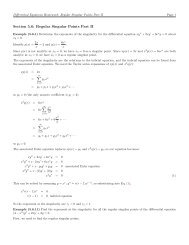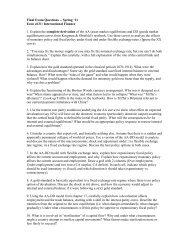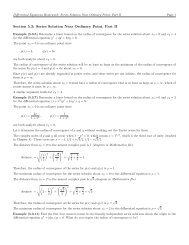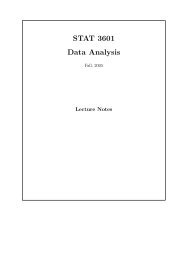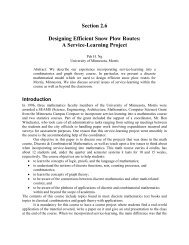Calculus I Homework: Linear Approximation and Differentials Page 1
Calculus I Homework: Linear Approximation and Differentials Page 1
Calculus I Homework: Linear Approximation and Differentials Page 1
Create successful ePaper yourself
Turn your PDF publications into a flip-book with our unique Google optimized e-Paper software.
<strong>Calculus</strong> I <strong>Homework</strong>: <strong>Linear</strong> <strong>Approximation</strong> <strong>and</strong> <strong>Differentials</strong> <strong>Page</strong> 3<br />
The blue line is the tangent line L(x), the red line is the function g(x), <strong>and</strong> the dots are where we evaluated to estimate<br />
the two numbers. We are evaluating along the tangent line rather than along the function g(x). We do this because<br />
it is easier to compute a numerical value along the tangent line than to compute a cube root directly. The further we<br />
move away from the center of the linearization a = 0, the worse our approximation generally becomes. We see that the<br />
approximation near x = 0.1 is worse than the approximation near x = −0.5, since the tangent line is further away from<br />
the curve g(x) at x = 0.1.<br />
Example Use differentials (or, equivalently, a linear approximation) to estimate the number ln 1.07.<br />
Using differentials would simply change the notation slightly. Let’s use the linearization notation.<br />
The linearization is given by L(x) = f(a) + f ′ (a)(x − a) which approximates the function f(x) near x = a.<br />
We need to identify what f(x) should be, <strong>and</strong> what our center should be. We are guided in our choice, because we want<br />
to be able to evaluate f(a) <strong>and</strong> f ′ (a) easily.<br />
An example of a poor choice would be f(x) = ln x <strong>and</strong> a = 1.07, since we would need to evaluate f(a) = ln 1.07, which is<br />
what we are trying to avoid!<br />
Instead, think of an easy number to evaluate the logarithm at. For logarithms, the easiest number is 1, since ln 1 = 0.<br />
Then, we will want x to be a small distance away from this number. This is the essence of the linearization procedure. So<br />
the function we want to linearize is f(x) = ln(1 + x), <strong>and</strong> we will choose a center of a = 0.<br />
Instructor: Barry McQuarrie Updated January 13, 2010





